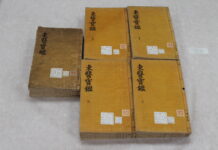Written By Jun Heo(許浚, 1539~1615), Translated by Namil Kim, Wung Seok Cha et al., Published by Ministry of Health & Welfare (Korea)
01 Shape of the Large Intestine 大腸形象 대장의 형상
① The large intestine is also known as the revolving intestine or the broad intestine. Its length is 2 gil 1 ja [2 ja according to some] and its width is 8 chon. Its diameter is over 2.5 chon and it weighs 2 geun 12 nyang. It winds to the right side and is piled up in 16 layers. It holds 2 mal of food and 7.5 doe of water.
② The length between the start and end of the stomach and intestines is 6 gil 4 chon 4 pun and there are 32 curves. In total, the stomach and intestines can hold 8 mal 7 doe 6 hop and 1/8 hop of food.
02 Area of the Large Intestine 大腸部位 대장의 부위
① The large intestine is adjacent to the spinal column at the back and receives waste from the small intestine. It winds to the right side of the navel and is piled up in layers. There are big wrinkles both above and below it and its exit at the bottom is connected to the anus.
② ST25 is the alarm point of the large intestine meridian (LI) and is located bilaterally at 3 chon to both sides of the navel. On the back, BL25 is located on both sides right below the 16th vertebra. This is the area of the large intestine.
03 Connections Between the Large and Small Intestines 大小腸連系 대소장의 연결
The large intestine system and small intestine system are connected to the heart, kidneys, and bladder through the spinal column below the diaphragm and are wrapped in wide layers of fat, membranes, ligaments, and collateral vessels. The layers can be differentiated according to distinct textures, and the large and small intestines and the bladder are linked by these weblike layers. These fine meridians transport qi, blood, fluid, and humor.
04 External Signs of the Large Intestine 大腸外候 대장의 외후
① It is possible to infer the large intestine’s status through the nose.
② As the lungs are in charge of the skin, if the skin is thick so is the large intestine, and if the skin is thin then the large intestine is also thin. If the skin is loose and the belly large, the large intestine is thick and long, and if the skin is tight, the large intestine is also tight and short. If the skin is smooth, the large intestine is straight. If the skin and flesh cannot be separated, this means that the large intestine is lumped together.
③ The distance between ST25 and KI11 is 6.5 chon. If the distance exceeds 6.5 chon, the large intestine is thick and long, and if the distance is shorter than 6.5 chon, the large intestine is narrow and short.
05 Large Intestine Disease Patterns 大腸病證 대장병증
① When the large intestine is diseased, the intestines rumble and ache as though they are being torn. If pathogenic cold repeatedly invades in winter, one suffers from diarrhea and pain in the navel and has difficulty standing for long periods.
② The following symptoms of stomachache, rumbling, reverse movement of qi towards the chest, shortness of breath, and difficulty standing for a long period of time all signify that there is pathogenic qi in the large intestine.
③ If the inner part of the intestines is cold, the stomach rumbles and food is not digested, and therefore maintains its shape in the feces. If the inner part of the intestines is hot, the feces are yellow and porridge like.
④ The illness of the large and small intestines is diarrhea.
⑤ When an intestinal impediment occurs, one drinks often but has difficulty urinating, the stomach rumbles and sometimes the ingested food comes out intact through the feces.
⑥ If there is coldness in the large intestine,the feces are normally soft as duck feces and if there is heat, the feces are oily.
⑦ The stomach rumbles both when the intestines are deficient and when pathogenic cold invades.
06 Treatment Methods for Large Intestine Disease 大腸病治法 대장병 치료법
① Huangdi (黃帝) asked, “The stomach dislikes heat and likes coldness. The large intestine dislikes coldness and likes heat. Given that the stomach and the large intestine do not correspond with each other, how can one control it?” Qibo (岐伯) answered, “One can control this by adjusting the food and clothing to the temperature. When the weather is cold, one should not dress too lightly and when the weather is hot, one should refrain from sweating too much. The food shall not be either too hot or too cold. If one adjusts to the temperature adequately and protects genuine qi, pathological qi shall not intrude.”
② When there is heat in the large intestine, one should use Drain White Decoction; when there is coldness, Replete Intestines Powder should be used.
Drain White Decoction 瀉白湯 사백탕: It treats large intestinal excess heat which manifests as navel and belly pain, abdominal bloating and distention, and/or constipation. 2 don of Rehmanniae Radix Crudus (生地黃), 1 don each of Poria Sclerotium Rubra (赤茯苓), Natrii Sulfas (芒硝), 5 pun each of Citrus Unshius Pericarpium (陳皮), Bambusae Caulis in Taeniam (竹茹), Scutellariae Radix (黃芩), Gardeniae Fructus (梔子), and Phellodendri Cortex (黃柏). Slice up these herbs and decoct them in water with 3 pieces of Zingiberis Rhizoma Crudus (生薑) and 2 Zizyphi Fructus (大棗) as 1 package.
Replete Intestines Powder 實腸散 실장산: It treats large intestinal deficiencies and coldness which manifests as a stomachache and/or diarrhea. 1 don each of Magnoliae Cortex (厚朴), Myristicae Semen (肉豆蔲) (roasted by burying in a fire turning to ashes), Terminaliae Cortex (訶子皮), Amomi Fructus (砂仁) (ground), Citrus Unshius Pericarpium (陳皮), Atractylodis Rhizoma (蒼朮), and Poria Sclerotium Rubra (赤茯苓), 5 pun each of Aucklandiae Radix (木香), and Glycyrrhizae Radix (甘草) (roasted). Slice up these herbs and decoct them in water with 3 pieces of Zingiberis Rhizoma Crudus (生薑) and 2 Zizyphi Fructus (大棗) as 1 package.
07 Symptoms for Expiration of Large Intestinal Qi 大腸病治法 대장병 치료법
Once the large intestinal qi expires, it cannot be treated. How can one know? If one experiences diarrhea continuously and then it suddenly stops, death is imminent.
08 Simple Prescriptions 單方단방
There are 24 kinds in total.
- Terminaliae Cortex 訶子皮: It stops diarrhea. Take in decoction or powder form.
- Skull of a yellow dog 黃狗頭骨: It stops dysentery and diarrhea. It is very effective for keeping the feces from leaking. Roast until yellow, grind into powder and take in the form of pills or with thin rice gruel.
Galla Rhois 五倍子: It treats diarrhea caused from intestine deficiency. It astringes the intestines and keeps the feces from leaking. Grind into powder and take mixed with water or in tablet form. - Granati Pericarpium 石榴殼: It stops diarrhea. Take in decoction or powder form.
- Arida Oryza Distillata 陳倉米: It stops diarrhea and controls the stomach. It can be taken either in the form of cooked rice, porridge, or thin rice gruel.
- Setariae Semen Praeparatum 粟米糗: It tonifies the large intestines. Mix the powder with water and take the mixture.
- Mume Fructus Praeparatum 烏梅: It stops diarrhea. Take in the form of tea.
- Querci Fructus 橡實: It thickens the intestines and stomach and stops diarrhea. Grind into powder and mix with thin rice gruel or take in the form of pills. Both ways of ingestion are fine.
- Ostreae Concha 牡蠣粉: It astringes both the small and large intestines. Grind into powder and mix with thin rice gruel or take in the form of pills.
- Pruni Nakaii Semen 郁李仁: It treats the aggregated qi inside the intestines. Grind into powder and mix with water.
- Rhei Radix et Rhizoma 大黃: It allows a free flow of the small and large intestines. Take in the form of a decoction or tablets. Both ways of ingestion are fine.
- Euphorbiae Lathyridis Semen 續隨子: It allows a free flow of the small and large intestines. Grind into powder and mix with water or take in the form of pills.
- Mori Cortex 桑白皮: It allows free flow within the small and large intestines. Decoct in water and ingest the decoction.
- Gardeniae Fructus 梔子: It treats severe heat of the small and large intestines. It can be taken decocted or as small doses of powder.
- Persicae Flos 挑花: It allows free flow within the small and large intestines. Collect when the flower falls, knead with flour, and roast the mixture into cakes to consume.
- Sesami Oleum 脂麻油: It is sesame oil. It allows improved flow within the small and large intestines. It can either be taken as is or mixed with water in the form of sesame porridge.
- Cannabis Semen 麻仁: It can be used when the feces have accumulated due to the wind-heat of the large intestines and do not come out easily. Get its juice by grinding and mix with water to make porridge.
- Oenanthis Javanicae Herba 水芹: It allows free flow within the small and large intestines. One can grind the leaves and stems and drink the juice or season and take as food consistently.
- Braseniae Schreberi Herba 絲蓴: It tonifies the qi of the small and large intestines in deficiency disorders. Broil soup with it or take pickled with salt.
- Allii Fistulosi Bulbus 蔥白: It allows improved flow within the small and large intestines. Grind raw and drink the juice, or decoct.
- Benincasae Semen 冬瓜: It allows free flow within the small and large intestines. Broil soup or season and take as food consistently.
- Brassicae Herba 菘菜: It allows the free flow within the intestines and stomach. Broil soup or season and take as food consistently.
- Bovis Lac / Milk 牛乳: It allows free flow within the large intestines. Make porridge and ingest consistently. It can also be taken uncooked.
- Hominis Urina 童尿: It allows free flow within the large intestines. It can either be taken mixed with Zingiberis Rhizoma Crudus juice or with a little bit of Glycyrrhizae Radix powder.






































